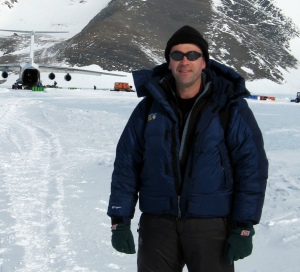

Glaciology expert, Martin Siegert, explains why the discovery of meltwater on an East Antarctic ice shelf could spell danger for the frozen continent.
Sea level could easily rise by a few meters if the ice shelves disintegrated.
– Professor Martin Siegert
Co-director, Grantham Institute
The giant grounded ice sheets of East and West Antarctica, which contain enough ice to raise sea levels by around 60 metres, are protected from direct contact with the open ocean by a series of floating ice shelves.
These ice shelves are under attack on two fronts: from below, warm ocean water that melts their undersides thinning the ice; and from above, meltwater on the surface of an ice shelf can also cause it to break up suddenly and catastrophically.
Professor Martin Siegert, expert glaciologist and Co-director of the Grantham Institute - Climate Change and the Environment, explains why new research published in the journal Nature Communications has surprisingly linked melting Antarctic ice to warm winds and not ocean temperatures.
Q: Tell us about the findings of this new study.
The study revealed that the large floating ice shelves that protect the grounded ice sheet from the ocean may be more vulnerable to break-up than previously thought. While there is not much melting of surface snow and ice in Antarctica, the study shows there is enough to melt the ice at the region between the grounded and floating ice. Previous studies have shown ice shelf break up from surface melting across the Antarctic Peninsula, but the new study reveals that it can happen in East Antarctica, which is much colder.
Q: Why is this a problem? How seriously should we take these signs?

Martin Siegert in Antarctica
The process has been identified in one East Antarctic ice shelf. But, if it’s found in others, then the grounded ice that it protects from the ocean may be more likely to flow to the sea, and raise sea levels globally, more than we had previously suspected.
The reason we’re concerned about the integrity of floating ice shelves today is because they protect so much grounded ice from reaching the ocean. Sea level could easily rise by a few meters if the ice shelves disintegrated, causing substantial issues for coastal defences and cities across the world.
Q: What is the difference between floating ice and ice that sits on the land?
The grounded ice sheet on land is massive. It can be over 4.5 kilometres thick. As the ice flows to the edge of the ice sheet it thins. If the ice rests on a bed below sea level, then eventually the thin ice will float, and become an ice shelf. The thickness of the ice shelf varies from around 1 kilometre at the grounding line, to 2-300 metres at its edge with the ocean. Ice shelves contain a lot of ice, but as they have already displaced their weight in water they don’t contribute directly to sea level change.
This should not be confused with sea ice, however. Sea ice is a very thin (1-2 metres) layer of ice that forms on the ocean surface. It surrounds the Antarctica, expanding in areal coverage during the winter and contracting in summer.
Q: How do scientists take measurements of the ice?
Field measurements are essential for this work. The team uses a combination of weather stations to get winds and temperature information, observations of melting, ice-penetrating radar to see under the ice surface and drilling to obtain direct access to the water collecting under the ice surface.
Q: Is this necessarily linked to climate change?
Yes. While the process may have been going on regardless of climate change, it will be increased by warming air temperatures.
Q: Describe for us a world with a completely ice-free Antarctic.
The last time Antarctica was completely free of ice was before it was cut off from South America, more than 34 million years ago. The world was very different then. Antarctica was green; it was teeming with plants and animals. Then the continent became climatically isolated due to an ocean current that wraps around the region stopping warm southward winds from reaching the continent.
Read more in an opinion piece by Professor Martin Siegert, in Nature Communications, which is published today.
Article text (excluding photos or graphics) available under an Attribution-NonCommercial-ShareAlike Creative Commons license.
Photos and graphics subject to third party copyright used with permission or © Imperial College London.
Reporter
Simon Levey
The Grantham Institute for Climate Change

Contact details
Tel: +44 (0)20 7594 5650
Email: s.levey@imperial.ac.uk
Show all stories by this author



Leave a comment
Your comment may be published, displaying your name as you provide it, unless you request otherwise. Your contact details will never be published.